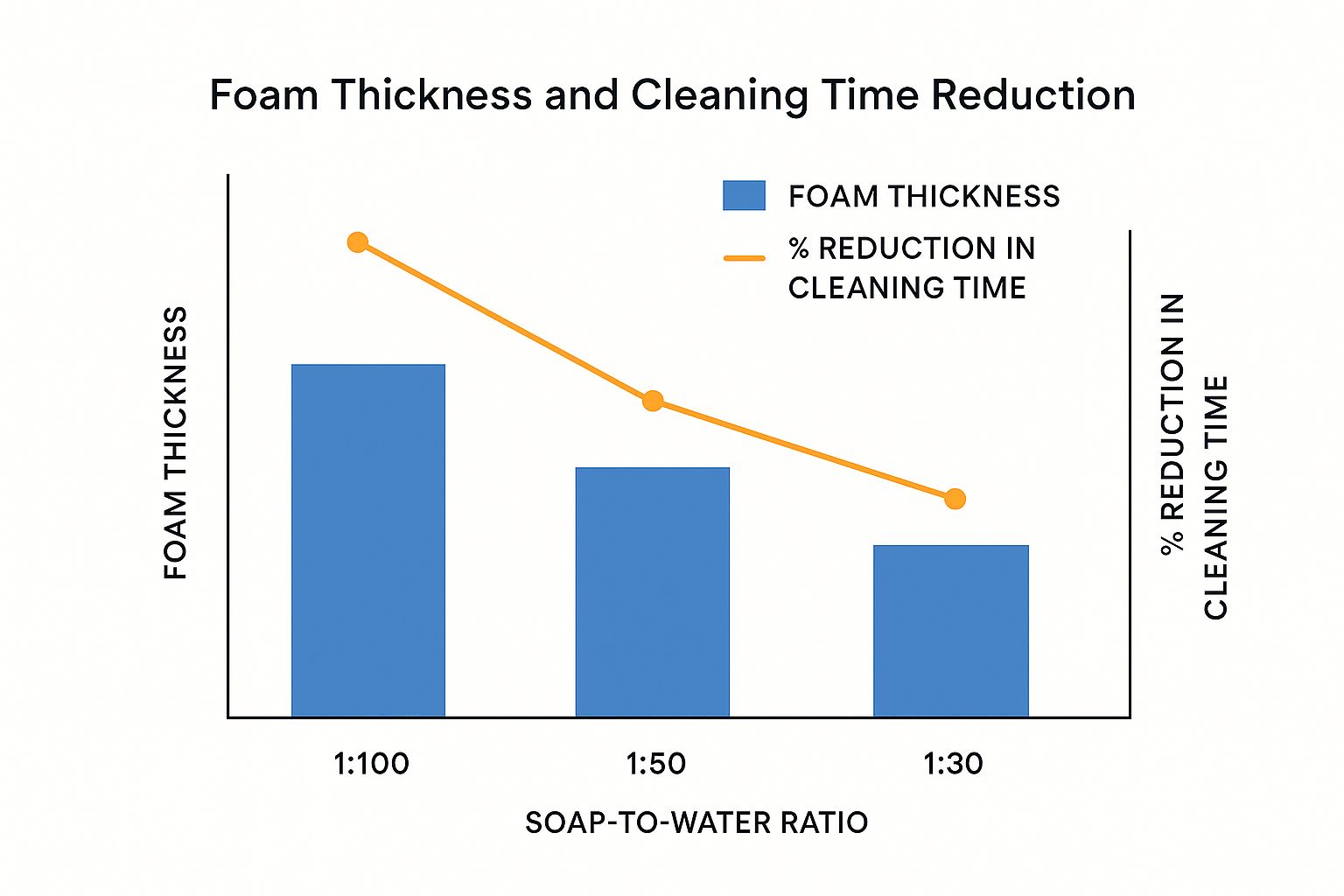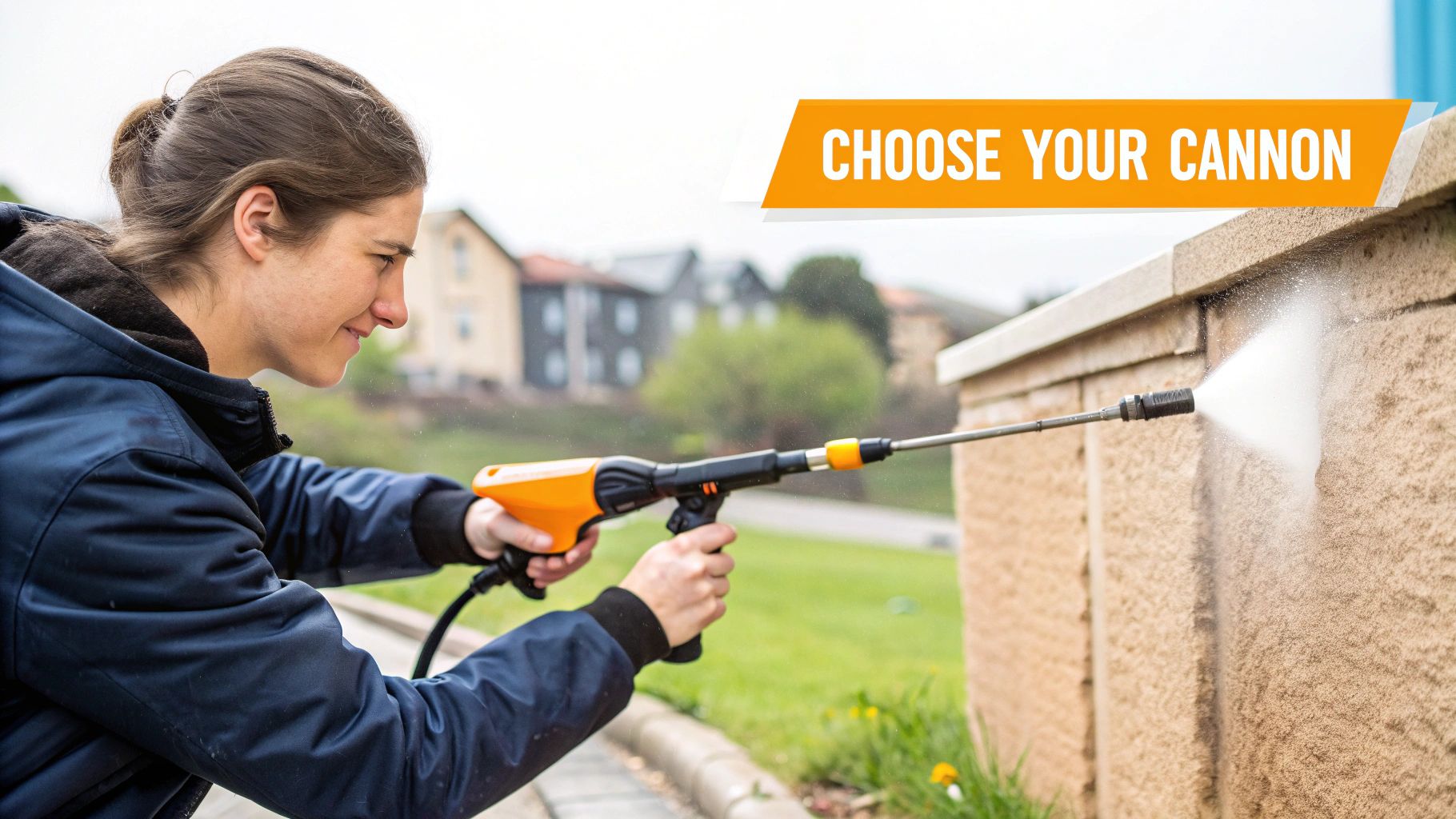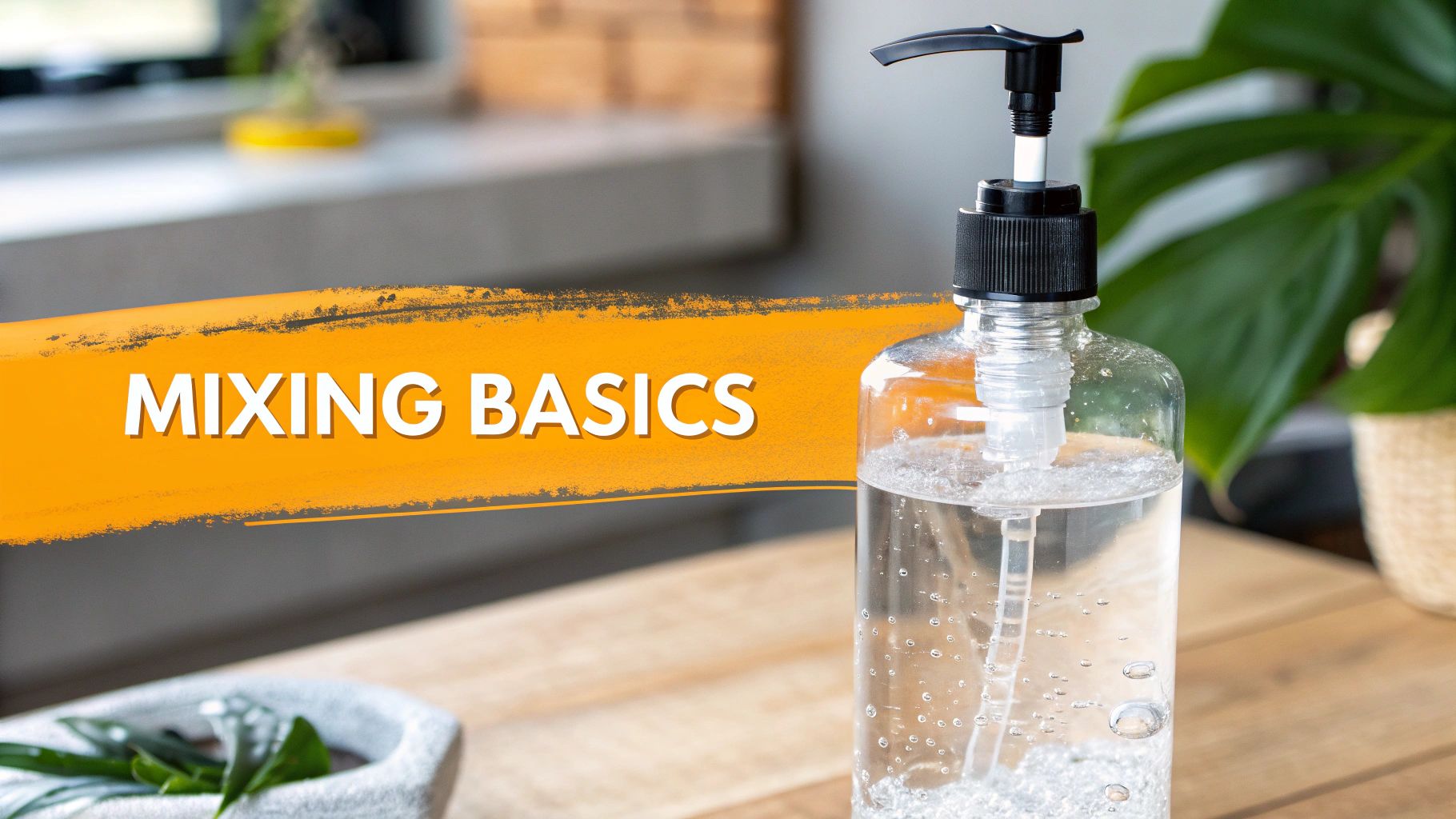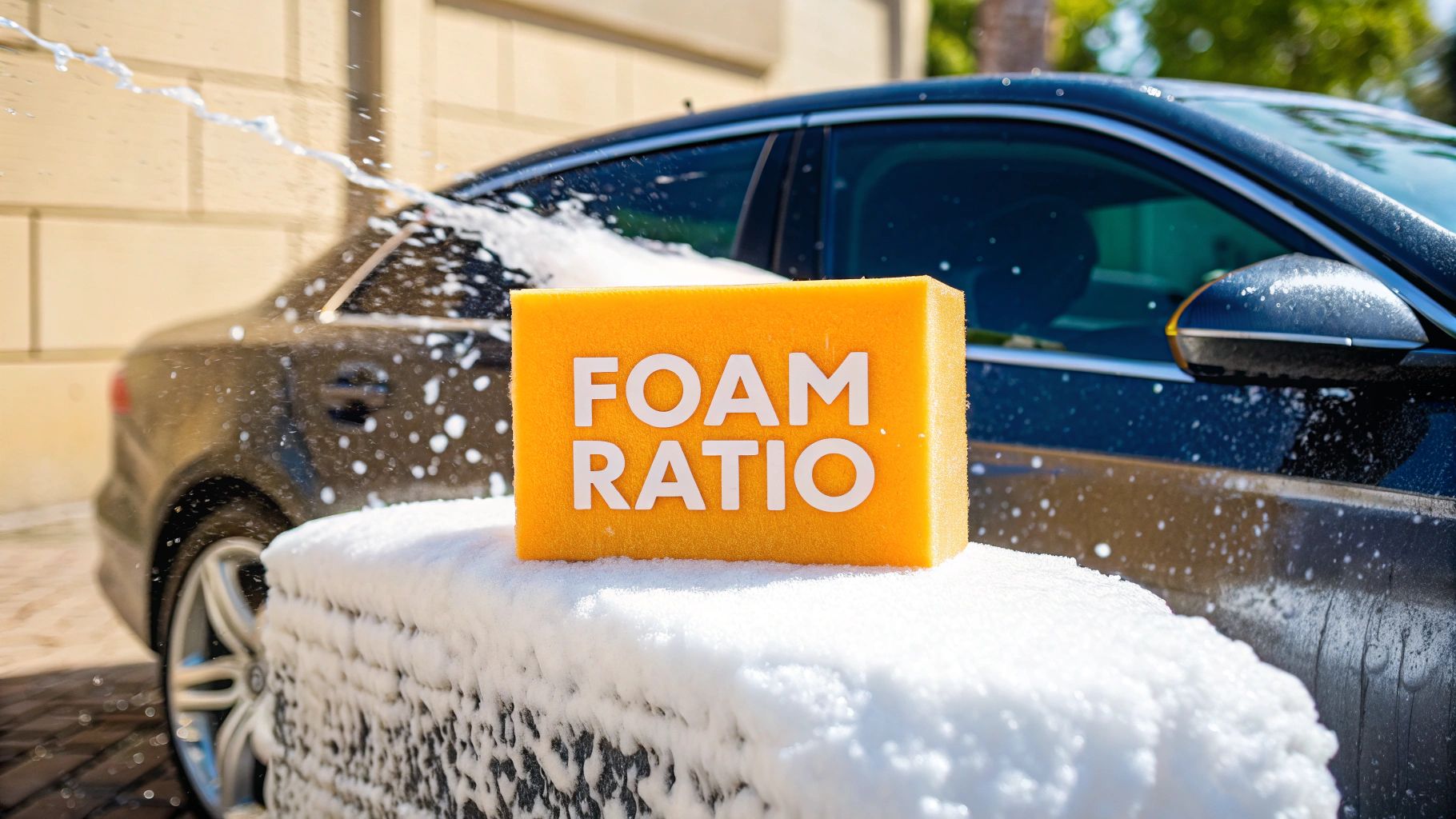Getting Your Foam Cannon Soap Ratio Right From The Start
Achieving that perfect, thick foam with your foam cannon isn't just about aesthetics. It's crucial for effective cleaning and protecting your car's finish. While the often-cited 1:10 soap-to-water ratio serves as a decent starting point, it’s rarely the perfect solution. Understanding the factors that influence this ratio is key to maximizing your foam cannon's performance.
Why the 1:10 Ratio Is Just a Starting Point
The 1:10 ratio provides a general guideline, but the optimal foam cannon soap ratio varies considerably. This variation is due to factors like the soap formulation, water hardness, and even the specific foam cannon you're using. A concentrated soap, for example, might require less product. A less concentrated formula may need a higher ratio.
The infographic below visualizes how different soap-to-water ratios impact both foam thickness and cleaning efficiency. Note how the percentage of cleaning time saved increases with foam thickness as the soap dwells longer.

Increasing soap concentration generally leads to thicker foam and potentially faster cleaning times, but going too thick isn't always best. The optimal ratio balances foam longevity, cleaning power, and product usage for both efficiency and effectiveness. The recommended starting point of 1:10 can vary depending on the specific foam cannon and soap.
Some soaps, like those from Chemical Guys, require mixing 1-3 ounces of soap with water in the foam cannon canister. Others, like the Super Soaper, achieve thick foam with just 2-4 ounces per use. The choice of soap and ratio significantly affects the foam quality and washing efficiency. For more insights, check out Car and Driver's Best Foam Cannons Tested.
Understanding Soap Formulations
Different soap brands and formulations have varying concentrations and foaming properties. A 1:10 ratio might produce fantastic results with one soap but be less effective with another. Premium soaps are often more concentrated, requiring a lower ratio due to their higher cleaning power per ounce.
Some soaps are designed for specific tasks, like stripping wax or tackling heavy grime. These specialized formulas may benefit from ratio adjustments. A thicker foam is ideal for dwelling and loosening stubborn dirt, while a thinner foam is sufficient for regular maintenance washes.
Water Hardness and Your Foam
Water hardness significantly impacts foam production. Hard water, containing high mineral content, hinders lathering and reduces foam thickness. If you live in an area with hard water, you might need to slightly increase your soap concentration to compensate. This ensures a thick, clinging foam for effective cleaning. Using a water softener or pre-filtering your water can also improve foam production and reduce soap consumption.
To help illustrate the variations in soap ratios, let's look at a few popular brands:
The following table summarizes the recommended soap-to-water ratios for some popular foam cannon soap brands. It highlights the recommended ratio, the equivalent ounces per gallon, typical foam thickness, and the best use case for each brand.
| Soap Brand | Recommended Ratio | Ounces per Gallon | Foam Thickness | Best Use Case |
|---|---|---|---|---|
| Chemical Guys Honeydew Snow Foam | 1:10 - 1:20 | 1.28 - 0.64 | Medium to Thick | Regular Maintenance Wash |
| Meguiar's Gold Class Car Wash Shampoo & Conditioner | 1:15 | 0.5 | Medium | Regular Wash and Wax Protection |
| Adam's Car Wash Shampoo | 1:20 | 0.4 | Medium | Regular Maintenance Wash |
| Griot's Garage Car Wash | 1:25 | 0.32 | Thin to Medium | Frequent Washing and Light Dirt |
As you can see, the recommended ratios and resulting foam thickness vary depending on the brand and its intended use.
Finding the perfect foam cannon soap ratio involves experimentation. Start with the recommended ratio and adjust based on your soap, foam cannon, and water conditions. Pay attention to the foam's consistency and how it clings to your vehicle. With practice, you'll be creating thick, satisfying foam that simplifies car washing.
Brand-Specific Mixing That Actually Works
Getting your car sparkling clean involves more than just grabbing any soap and a foam cannon. Manufacturer recommendations for foam cannon soap ratios are often just a starting point. Through real-world testing, we've discovered the optimal ratios for top brands, leading to truly impressive cleaning results. Understanding the nuances of concentrated formulas like Chemical Guys versus balanced blends like Adam's Polishes can dramatically enhance your car washing experience.
Soap Brand Nuances: Concentration and Adjustments
Chemical Guys, renowned for its concentrated soaps, offers some surprising opportunities for optimization. Often, these soaps produce excellent foam at half the recommended concentration. This translates to achieving the same cleaning power while using less product and saving money. For example, if the bottle suggests a 1:10 ratio, try experimenting with 1:20. You might find the foam remains thick and effective. Interested in learning more about car washing techniques? Check out this helpful guide: How to master the perfect car wash.
Adam's Polishes, in contrast, often necessitates adhering more closely to the recommended ratios. Their balanced blends are designed for a specific dilution, and straying too far can impact performance. Minor adjustments are generally acceptable, but substantial changes might lead to thinner foam or diminished cleaning power.
Maximizing Formula Potential: Insider Tips
Professional detailers have learned the secrets to getting the most out of various soap brands. With Chemical Guys, experimentation is key. They often strive to pinpoint the "sweet spot" – the minimum amount of soap needed for maximum foam production. This brand often rewards a bit of trial and error. With Adam's Polishes, consistency is paramount. The focus is on precise mixing and proper dilution for dependable, reliable cleaning performance. It's much like baking: some recipes offer flexibility, while others demand precision.
Troubleshooting Brand Recommendations
Sometimes, a brand's recommended ratio simply doesn't produce the desired results with your specific foam cannon. This can be frustrating, but there are solutions. Here are a few adjustments employed by professional detailers:
-
Thin, Weak Foam: Begin by double-checking your foam cannon's settings. If the soap is diluted according to the recommendations, but the foam is still weak, adjustments to your foam cannon might be necessary.
-
Thick, Clogging Foam: If the foam is excessively thick and clogs your foam cannon, gradually reduce the soap concentration. Find the balance between thick, rich foam and smooth flow through your equipment. This often occurs with highly concentrated soaps.
-
Inconsistent Foam: Inconsistent foam often indicates inconsistent mixing. Pre-mixing your soap solution in a separate container before adding it to the foam cannon can ensure even distribution and consistent results.
By understanding the unique characteristics of each soap brand and incorporating a few professional tips, you can maximize the effectiveness of your foam cannon and achieve a truly professional-level clean. Consistent, thick, and long-lasting foam is not just visually appealing; it plays a crucial role in lifting and encapsulating dirt, protecting your car's finish, and making the entire car washing process more enjoyable.
Fixing Foam Cannon Problems That Drive You Crazy
Thin, disappointing foam that vanishes before you finish spraying? Or perhaps overly thick foam that clogs your equipment? We’ve all been there. These frustrating issues often stem from incorrect foam cannon soap ratios. Thankfully, the solutions are usually simple. Through troubleshooting methods developed with professional detailers, you can diagnose and fix common foam cannon problems, whether they’re caused by soap concentration, mixing technique, your equipment, or even the weather.

Diagnosing the Root of the Problem
First, consider your soap concentration. Is your foam too thin? This usually indicates you need more soap in your mix. Start by increasing the soap concentration slightly, testing, and adjusting until you achieve the desired thickness. Conversely, excessively thick foam may require a lower soap concentration.
Next, examine your mixing technique. Inconsistent foam often results from uneven mixing. Pre-mixing your soap and water in a separate container before adding it to the foam cannon can greatly improve consistency. It's similar to mixing pancake batter – a smooth, consistent batter makes perfect pancakes, just as a well-mixed soap solution produces superior foam.
Troubleshooting Common Foam Cannon Issues
Let's address some common scenarios: foam that looks great initially but disappears quickly often indicates a problem with the soap itself or environmental conditions like high temperatures. Try a different soap brand or adjust your ratio. You might be interested in: How to master the perfect car wash.
Ratios that work perfectly one day but fail the next can be caused by inconsistent water pressure or temperature fluctuations. Check your pressure washer's settings and ensure a consistent water temperature.
Adapting to Seasonal Changes
Seasonal changes can impact your foam. In warmer weather, water evaporates more quickly, leading to thinner foam. You might need to increase your soap concentration during summer. Colder temperatures can thicken the soap mixture, requiring a slight reduction in concentration.
Here’s a quick guide to help troubleshoot these issues:
- Foam disappears too quickly: Increase soap concentration, try a different soap, or consider environmental factors like high temperatures.
- Foam is too thick and clogs: Reduce soap concentration or try pre-mixing your solution.
- Inconsistent foam: Ensure even mixing by pre-mixing the soap and water in a separate container.
- Seasonal variations: Increase soap concentration in warmer months and reduce it in colder months.
By understanding these common foam cannon problems and implementing the right fixes, you’ll be creating thick, lasting foam for a better car wash every time. This consistent, high-quality foam isn’t just satisfying; it's crucial for loosening dirt effectively and protecting your car’s paint.
Advanced Techniques That Separate Pros From Beginners

Ready to take your car washing to the next level? Here's how to achieve professional results with your foam cannon. These advanced techniques will transform your foam cannon from a basic tool into a precision instrument, unlocking the secrets to thick, clinging foam that not only looks impressive but also boosts cleaning power.
The Power of Pre-Mixing
One technique that distinguishes experienced detailers is pre-mixing their foam cannon soap solution. Instead of adding soap and water directly to the foam cannon bottle, pre-mixing in a separate container ensures even soap distribution. This leads to consistent foam quality and prevents clogs, eliminating inconsistencies for a smooth, even foam every time. For instance, with highly concentrated soaps, pre-mixing allows for better dilution and prevents undissolved soap clumps from clogging the foam cannon.
Temperature Tricks: Hot vs. Cold
Water temperature significantly impacts foam cannon soap ratios. Hot water creates thinner foam due to increased evaporation, while cold water produces thicker, denser foam. This requires adjusting your soap ratio seasonally. During summer, increase the soap concentration to compensate for thinner foam caused by hot water. Conversely, reduce the concentration in colder months to avoid overly thick foam.
Layering for Lasting Foam
The layering technique is a professional secret for remarkably thick, long-lasting foam. Apply an initial foam layer, let it dwell for a minute or two, then apply a second layer. This creates a denser foam that clings longer, maximizing cleaning power, especially for stubborn dirt and grime. This technique allows the foam to penetrate and loosen dirt more effectively. Learn more in our article about How to Master the Perfect Car Wash.
Professional Secrets for Maximum Impact
Professional detailers understand that perfect foam isn't just about appearance; it's about maximizing cleaning power. They adjust soap ratios based on the dirt and grime they're tackling. For heavy dirt, a thicker foam is essential. For light dirt or maintenance washes, a thinner foam suffices. By fine-tuning the foam cannon soap ratio, professionals balance cleaning effectiveness and product efficiency. These subtle adjustments distinguish the pros from the amateurs, demonstrating a commitment to quality car care and leading to superior results.
Equipment And Environment Factors You Can't Ignore
Your ideal foam cannon soap ratio isn't a fixed number. It's constantly influenced by your equipment and environment. Overlooking these factors often leads to inconsistent results. Let's explore how these elements impact your foam and how to adjust accordingly.
Foam Cannon Variations and Their Impact
Different foam cannons have unique characteristics. Some have adjustable nozzles, giving you control over foam thickness. Others have fixed nozzles, requiring soap ratio adjustments for desired consistency. This means a ratio perfect for one foam cannon might not work for another. For example, a wider nozzle might need a higher soap concentration than a narrower one to achieve the same thickness.
Pressure Washer PSI and GPM: More Important Than You Think
Your pressure washer's PSI (pounds per square inch) and GPM (gallons per minute) ratings significantly impact foam production. Higher PSI creates thicker foam. Higher GPM can dilute the mixture, resulting in thinner foam. You'll need to adjust your soap ratio accordingly. A lower PSI/GPM pressure washer might need a higher soap-to-water ratio.
Nozzle Selection: A Small Change With Big Consequences
Nozzle selection dramatically affects your soap ratio. A wider nozzle disperses the solution, creating thinner foam. A narrower nozzle concentrates it, producing thicker foam. Choosing the right nozzle is crucial. For larger vehicles, a wider nozzle is efficient, but you'll likely need a higher soap ratio for thicker foam.
Environmental Factors: Temperature, Humidity, and Water Hardness
Environmental conditions play a surprisingly significant role. Higher temperatures cause faster evaporation, leading to thinner foam. High humidity affects foam stability. Hard water hinders lathering and reduces foam thickness. These conditions change throughout the year. Your perfect summer ratio might be unsuitable for winter. Seasonal adjustments are often necessary. For instance, decrease soap concentration in winter due to colder temperatures.
Altitude's Effect on Foam Production
Altitude also impacts your foam cannon soap ratio. Lower air pressure at higher altitudes affects the foam cannon's ability to create thick foam. You may need to increase your soap concentration at higher altitudes. This ensures consistent foam performance regardless of location. Neglecting altitude can result in thinner, less effective foam.
Smart Economics and Market Insights For Better Value
Perfecting your foam cannon soap ratio isn't just about achieving impressive foam; it’s about smart spending. Small adjustments to your soap-to-water ratio can significantly impact your cost per wash, without sacrificing cleaning power or foam quality. This section explores the economics of different mixing ratios and how to make informed purchasing decisions that align with your budget and washing routine.
The Real Cost of Your Foam: Breaking Down the Economics
Consider this: using slightly less soap in each wash, while still achieving effective cleaning, can drastically reduce your long-term soap costs. For example, if you typically use 4 ounces of soap per wash and reduce it to 3 ounces by optimizing your ratio, you've saved 25% of your soap cost per wash. This seemingly small change adds up over time, especially for frequent washers. For more insights on minimizing waste with a foam cannon, visit the Sure Space blog.
Additionally, understanding how different soap brands and their respective concentrations affect your ratio can lead to further savings. Premium soaps, often more concentrated, might initially seem more expensive. However, their higher cleaning power per ounce can mean you use less product overall, potentially offsetting the higher initial cost.
Bulk Buying and Proper Ratios: A Winning Combination
Knowing your ideal foam cannon soap ratio allows you to take advantage of bulk buying opportunities. Purchasing larger quantities of soap often comes with substantial discounts. When you combine this with a dialed-in ratio that minimizes soap usage per wash, you maximize your savings. This is especially beneficial for those who wash their cars frequently or detail multiple vehicles.
Market Trends: Growth and Competitive Pricing
The car wash soap market is booming. In fact, the global market is projected to grow from $10,060.4 million in 2024 to $16,702.2 million by 2034, a 5.2% CAGR. This expansion is driven by increasing vehicle ownership and a growing awareness of car hygiene. This growth translates to more product choices and competitive pricing for consumers. Find more detailed statistics here.
Calculating Your True Cost Per Use
To make the smartest purchasing decisions, calculate your true cost per use. This involves considering the soap price, your optimized ratio, and the number of washes you get per container. This allows you to compare different brands and dilution rates effectively, factoring in both performance and value. By understanding these economic factors, you’ll not only achieve the perfect foam but also make smart, cost-effective choices that benefit your wallet and your car.

Quick Reference Guide For Consistent Success
This guide is your cheat sheet for achieving perfect foam every time you use your foam cannon. Bookmark this page for easy access to mixing ratios, procedures, troubleshooting tips, and seasonal adjustments. Whether you're a beginner or a seasoned pro, this guide will help you achieve thick, lasting foam and a superior clean.
Brand-Specific Ratio Charts
Knowing the right starting point for your soap is crucial. This chart offers general guidelines, but remember that experimentation is key to finding the perfect mix for your setup.
| Brand | Starting Ratio | Adjustment Notes |
|---|---|---|
| Chemical Guys | 1:15 | Often performs well at higher dilutions (1:20+) |
| Meguiar's | 1:15 | Adjust slightly based on foam consistency |
| Adam's Polishes | 1:20 | Stick close to recommendations |
| Griot's Garage | 1:25 | May need slight increase for thicker foam |
Mixing Procedures: Eliminating the Guesswork
Consistent mixing is the key to perfect foam. Follow these steps for optimal results:
-
Pre-mix: Combine soap and water in a separate container before adding it to the foam cannon. This ensures even distribution and prevents clogs.
-
Measure Carefully: Use measuring cups or a mixing bottle for accuracy. Eyeballing can lead to inconsistencies.
-
Adjust Gradually: Start with the recommended ratio and adjust in small increments based on the results. Avoid large, sudden changes.
To help you dial in your perfect mix, here's a quick reference chart for various scenarios:
Foam Cannon Soap Ratio Quick Reference Chart At-a-glance mixing ratios and troubleshooting guide for common scenarios
| Scenario | Soap Ratio | Water Amount (Example using a 32oz bottle) | Expected Result | Troubleshooting Tip |
|---|---|---|---|---|
| Starting Point for Most Soaps | 1:15 | 2oz soap, 30oz water | Thick, clinging foam | Adjust ratio as needed based on your specific soap |
| Thin Foam | 1:10 | 3oz soap, 29oz water | Increased foam thickness | Check for clogged nozzles and adequate pressure washer settings |
| Thick, Clogging Foam | 1:20 | 1.5oz soap, 30.5oz water | Reduced foam thickness, less clogging | Try pre-mixing more thoroughly |
| Hard Water | 1:10 to 1:15 (Start higher and adjust) | 2-3oz soap, 29-30oz water | Improved foam production in challenging water | Consider using a water softener |
This chart provides a practical guide to help you quickly adjust your mixture and troubleshoot common issues. Remember to always test on a small area first before covering your entire vehicle.
Troubleshooting Checklist: Common Foam Cannon Problems
If you're experiencing issues, consult this checklist:
-
Thin Foam: Increase soap concentration, check for clogged nozzles, and ensure your pressure washer settings are correct.
-
Thick, Clogging Foam: Decrease soap concentration and pre-mix more thoroughly.
-
Inconsistent Foam: Ensure even mixing by pre-mixing the solution and check for fluctuating water pressure.
Seasonal Adjustments: Staying Ahead of Changing Conditions
Adapt your foam cannon approach throughout the year:
-
Summer: Increase soap concentration to combat faster evaporation.
-
Winter: Decrease concentration to prevent overly thick foam.
-
Hard Water: A water softener or pre-filter can greatly improve foam production.
Quality Checkpoints
Use these checkpoints to ensure your foam is performing optimally:
-
Cling: The foam should adhere to the vehicle for several minutes.
-
Coverage: Aim for even coverage across all surfaces.
-
Rinse: The foam should rinse cleanly without leaving residue.
Ready to upgrade your car wash routine? The SwiftJet Car Wash Foam Gun offers thick, clinging foam and comes with a free microfiber mitt. Enjoy free shipping on orders over $49. Visit SwiftJet today!
